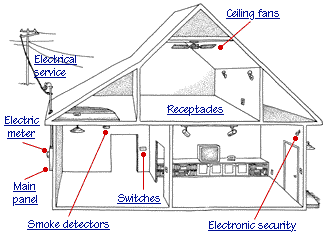KEEPING YOU INFORMED:
Insurance Companies’ Approach to 60 Amp Service and Knob & Tube Wiring
In keeping you in touch with new developments related to the Real Estate / Home Inspection industry it has been confirmed that most insurance companies are unwilling to insure a home with a 60-Amp electrical service.
It has been noted that the 60-amp service was not, in itself, unsafe, but was often a reflection on the overall electrical service. From an underwriting standpoint, more often than not, this reflects a risk these companies do not want. Since there are only a small number of homes left with 60-amp service (based on their policy population), they feel comfortable in turning down the business for these homes.
It should also be noted that a 60-amp service might be perfectly adequate, depending on lifestyle, and that the Ontario Electrical Code does not allow new houses to be built with 60-amp service under any circumstances.
In conclusion you might be well advised to let your clients know that some insurers will not consider homes with 60-amp service. Even though we as Home Inspectors look foolish in saying that these services are okay, it should be pointed out by Real Estate agents / Home Inspectors alike, that the insurance companies’ reasons are not strictly safety, but are generally the result of using a coarse, easily identifiable indicator as a statistically significant representation of the overall electrical service condition.
Knob & Tube Wiring
A similar reluctance for insurance companies towards knob and tube wiring is prevalent even though the Ontario Hydro, as the authority, defends it. Genmark Insurance is one company that may provide insurance coverage across Ontario for homes with knob and tube wiring. They can be contacted at 416-4820-2089. Again, in the short term, you might be well advised to let your clients know that they might have trouble getting insurance on houses with knob & tube wiring.
Home Wiring Hazards
Are you alert to the warnings your home wiring system may be sending? Signs of potential safety hazards include the following:
- Power Outages – fuses need replacement or circuit breakers need resetting frequently
- Dim/flickering lights – lights dim or the size of your television picture shrinks often
- Arcs/sparks – bright light flashes or showers of sparks are sighted anywhere in your electrical system
- Sizzles/buzzes – unusual sounds are heard from your electrical system
- Odors – burned or overheated wires often give off an odor of hot insulation
- Loose plugs – attachment plugs wobble or pull out of a receptacle too easily
- Damaged wire insulation – insulation is cut, broken, or cracked
- Overheating – parts of your electrical system, such as switch plates, receptacle outlet covers, cords and plugs may be warm, but should never be too hot or painful to touch or be discoloured from heat
- Electrical shocks – any shock, even a mild tingle, may be a warning of potential for electrocution
- “Overfused” (sometimes called “over-amped”) panel – this situation occurs when an electrical panel contains fuses or circuit breakers rated at higher current than the ampacity (current capacity) of their branch circuits
- Permanently installed extension cords are intended to be used They should not be used for a long period to connect an appliance with a cord too short to reach the receptacle outlet.
If you experience any of these problems, seek the help of an electrical professional. Like other parts of your home, the electrical system ages and wears out: monitor its condition regularly and make necessary repairs before accidents occur. About once a year, check your circuit breakers as well. You can do this by flipping them off and on and checking that the appropriate circuits respond as intended.



